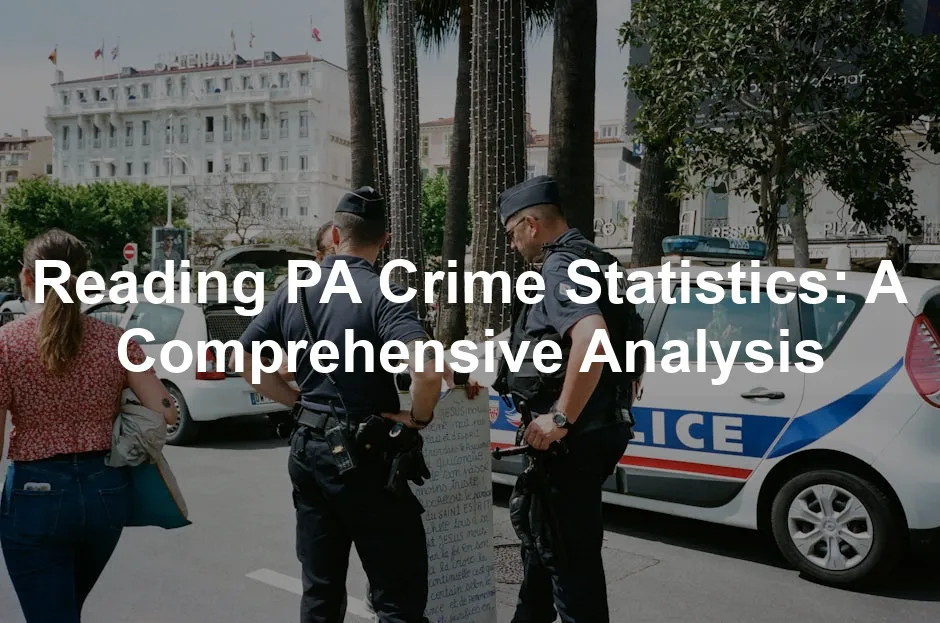Introduction
Reading, Pennsylvania, has a rich history dating back to its founding in 1748. Once a bustling hub for the transportation of goods, this city has evolved into a diverse community. However, like many urban areas, Reading faces challenges, particularly regarding crime. Understanding crime statistics in Reading is essential for grasping community safety and public perception. Crime statistics act as a mirror reflecting the safety of neighborhoods. They help residents, potential newcomers, and local authorities assess risks and implement effective strategies. When you know the numbers, you can make informed decisions about where to live, work, and play. In this article, we will provide a thorough analysis of crime statistics in Reading, PA. We will explore various aspects, including general crime rates, comparisons to state and national averages, and insights into how crime has evolved over the years. Additionally, we will highlight specific crime categories such as violent and property crimes. This comprehensive approach aims to equip readers with a well-rounded understanding of crime in Reading, empowering them to engage in community discussions regarding safety and security.
Understanding Crime in Reading, PA
Overview of Reading’s Crime Landscape
Reading’s crime landscape presents a unique picture. Analyzing the statistics reveals that Reading’s crime rate is notably higher than national averages. The total crime rate stands at approximately 25.76 per 1,000 residents, with a shocking 1 in 50 chances of becoming a victim of property crime. When we focus on violent crimes, the numbers are equally concerning, with a violent crime rate of 5.96 per 1,000 residents. In comparison to Pennsylvania’s averages, Reading’s crime rates indicate a troubling trend. For example, while the state averages for violent crime hover around 3.7 per 1,000 residents, Reading’s figures soar above this mark. On a national level, Reading’s crime rates are also significantly higher than the average, showing that residents are facing unique challenges related to safety. Breaking it down further, we see that violent crimes in Reading account for approximately 565 incidents, while property crimes make up the bulk, with 1,879 reported incidents. This disproportion highlights the need for community awareness and proactive measures. Moreover, Reading has one of the highest rates of motor vehicle theft in the nation, which raises alarm bells for residents and local authorities alike. The implications of such statistics can be profound, often leading to heightened community concerns and calls for increased law enforcement efforts. In summary, Reading’s crime statistics paint a stark picture. The numbers tell a story of challenges that local residents face daily, emphasizing the importance of understanding these statistics for fostering community engagement and safety initiatives.
To enhance your home security, consider investing in a Home Security Camera System. It allows you to monitor your property, providing peace of mind and keeping an eye on any suspicious activity.
Historical Context
Reading, PA, has witnessed a rollercoaster of crime trends over the decades. Back in the 1980s, the city experienced a crime wave, much like a bad hair day that just wouldn’t end. The 1990s brought a glimmer of hope, as crime rates began to dip. By the early 2000s, it seemed as if Reading was ready to turn a new leaf. However, that optimism was short-lived, with crime rates showing an uptick in subsequent years. Significant events have shaped these trends. The economic downturns in the late 2000s led to increased unemployment, which often correlates with higher crime rates. Furthermore, the rise of gang activity in the area has also played a role in shaping Reading’s crime landscape. To help visualize this turbulent history, let’s take a look at a simplified timeline of crime rate changes in Reading:- 1980s: High crime rates peak, mirroring national trends.
- 1990s: A gradual decline begins, as community initiatives take root.
- 2000s: Economic struggles contribute to fluctuating crime rates.
- 2010s: A mixed bag; some years see improvements, while others reflect a resurgence in violence.
- 2020s: Recent data indicates a concerning rise in violent and property crimes, despite overall improvements in some neighborhoods.

Detailed Crime Statistics
Violent Crime Statistics
Definition of Violent Crimes
Violent crimes include serious offenses that threaten personal safety. These typically consist of murder, assault, robbery, and rape. Each of these categories carries significant weight in assessing community safety. They are not just numbers; they represent lives affected, families torn apart, and neighborhoods shaken.Current Violent Crime Rates
As of the latest data, Reading has a violent crime rate of 5.96 per 1,000 residents. To put this in perspective, you might feel like you’re playing a game of dodgeball, but the odds are not in your favor. When comparing this to Pennsylvania’s average of 3.7 per 1,000 residents, it’s clear that Reading faces challenges. Nationally, the average sits at about 4.0 per 1,000, making Reading’s statistics even more alarming. Chances of becoming a victim of a violent crime in Reading are roughly 1 in 168, which is like playing roulette—except nobody is winning. This statistic highlights the importance of raising awareness and taking preventive action to enhance community safety.
For added personal safety, consider keeping a Personal Safety Alarm Keychain handy. It’s a small device that can emit a loud sound, attracting attention and scaring off potential threats.
Historical Data on Violent Crimes
Analyzing the trend of violent crimes in Reading reveals a complex pattern. A graph depicting violent crime rates over the last decade illustrates peaks and valleys. For instance, while 2018 saw a spike with a rate of 701.96 per 100,000 residents, there have been fluctuations in subsequent years. In 2020, the rate dropped to approximately 256.9, only to rise again in 2022 to 507 per 100,000. The following chart summarizes the violent crime rates in Reading over recent years:| Year | Violent Crime Rate (per 100,000) |
|---|---|
| 2018 | 701.96 |
| 2019 | 292.5 |
| 2020 | 256.9 |
| 2021 | 309.9 |
| 2022 | 507 |

Property Crime Statistics
Definition of Property Crimes
Property crimes are offenses that involve the theft or destruction of someone else’s property. They aren’t exactly a pick-me-up for the community, but understanding them can help residents feel safer. Here are the primary categories of property crimes:- Burglary: Breaking into a building with the intent to commit a crime, usually theft. Think of it as an unwanted guest at a party, but instead of cake, they’re after your valuables.
- Theft: This is the act of stealing someone’s property. Unlike burglary, theft doesn’t require breaking and entering. It’s more like that sneaky friend who “borrows” your favorite sweater and “forgets” to return it.
- Vandalism: This involves damaging or defacing property. Whether it’s graffiti or broken windows, vandalism is like a bad haircut—it leaves a mark that’s hard to ignore.
- Motor Vehicle Theft: Stealing a car or any vehicle. With the rise in this crime, parking your cherished wheels might feel like leaving your lunch unattended in the break room—risky business!

Current Property Crime Rates
The current landscape of property crimes in Reading is a cause for concern. The property crime rate stands at approximately 19.81 per 1,000 residents. To put that into perspective, your chances of becoming a victim of a property crime here are about 1 in 50. When we compare this to the state average of around 12 per 1,000 residents, it’s clear that Reading is facing a tougher battle. Nationally, the average property crime rate is about 35.4 per 1,000 residents, which means Reading’s numbers are not just high; they’re alarmingly significant. This discrepancy raises flags for local authorities and community members alike, indicating a need for targeted crime prevention strategies.
For those looking to enhance their home security further, consider installing Motion Sensor Outdoor Lights. They can deter potential intruders by illuminating your property when movement is detected.
Historical Data on Property Crimes
Looking at the historical trends of property crimes in Reading reveals a rollercoaster of data. Over the past decade, the rates have fluctuated, often mirroring broader economic conditions. From 2010 to 2020, property crime rates showed an upward trend, peaking in 2018. This spike can be attributed to various factors, including economic hardship and increased gang activity. However, recent years have seen a slight decline, suggesting that community efforts and law enforcement initiatives are beginning to yield results. Visual representations of this data can provide clarity. A line graph illustrating property crime rates from 2010 to 2023 would show:- 2010: 17.5 incidents per 1,000 residents
- 2015: 20.3 incidents per 1,000 residents
- 2018: 22.7 incidents per 1,000 residents
- 2020: 19.2 incidents per 1,000 residents
- 2023: 18.5 incidents per 1,000 residents

Crime Rate Rankings
Reading, PA, has earned its place in the spotlight when it comes to crime rates in Pennsylvania. In fact, it ranks among the cities with the highest crime rates in the state. According to recent statistics, the total crime rate in Reading stands at approximately 25.76 per 1,000 residents. This figure is a stark reminder that safety isn’t a guarantee, and it’s certainly a conversation starter among locals and potential newcomers. For the residents, these rankings carry significant weight. When people consider relocating, they often check the crime rates. High rankings can deter newcomers, making them think twice about settling in. For current residents, it’s a call to action. They might feel motivated to engage with local community programs aimed at reducing crime. It’s all about creating a safer environment. Understanding these statistics is critical. A high crime rate can lead to increased anxiety and a sense of vulnerability. But it can also mobilize the community. Residents may rally for better law enforcement presence or participate in neighborhood watch programs. So, while the rankings might initially seem alarming, they can also foster a proactive mindset among citizens.
To further enhance community safety, consider displaying a Neighborhood Watch Sign in your area. It can deter criminals by showing that residents are vigilant and looking out for each other.
Perceptions of Safety in Reading
Community Sentiment
Polls reveal a mixed bag when it comes to how residents feel about safety in Reading. In a recent survey, about 42% of respondents indicated they felt “somewhat safe.” This sentiment reflects a cautious approach to safety, where residents acknowledge concerns but still manage to navigate their daily lives. On the flip side, a notable 19% of residents reported feeling “not safe.” This group experiences heightened anxiety, often questioning whether it’s safe to walk home after dark or to leave their homes unattended. Meanwhile, only 6% of respondents felt “very safe,” indicating a stark contrast in perceptions. These sentiments underscore the importance of community efforts to bolster safety. When a significant portion of the population feels uneasy, it can lead to a collective push for change. As more residents express their concerns, local authorities may feel encouraged to enhance security measures, engage in community outreach, and increase police presence.
Law Enforcement Effectiveness
When discussing perceptions of safety, law enforcement’s effectiveness often comes into play. In Reading, 29% of poll respondents believe the police are “very visible and responsive.” This assurance can provide peace of mind, knowing help is just a call away. However, an equal percentage feel the police are “not around much” but respond quickly when needed. Yet, 26% of residents shared concerns that police visibility exists but response times are slow. This can exacerbate worries, especially when immediate assistance is crucial. Interestingly, 11% of respondents felt that police aren’t reliable when called upon, revealing a significant gap in trust. These insights highlight the need for improved community policing strategies. Building relationships between law enforcement and residents can foster trust and enhance perceptions of safety. When citizens feel supported by their police force, they are more likely to engage in community-led safety initiatives, creating a more secure environment for everyone. By understanding community sentiment and law enforcement effectiveness, Reading can better address safety concerns and work towards a more cohesive, secure community.
Safest Neighborhoods in Reading
Overview of Safer Areas
Reading, PA, may boast some neighborhoods where safety is a little less like a game of dodgeball. Among these havens, Fritztown and Grings Hill Estates/Montello stand out as top picks. Residents here enjoy a sense of community and lower crime rates, making it feel like home sweet home. Brownsville/Cacoosing is another gem, where neighbors know each other and crime feels like an unwelcome guest. Mohns Hill/Spring Dale Heights and Limekiln are also worth mentioning, offering peace of mind to families and newcomers alike. Reiffton and Jacksonwald round out the list of safer areas, combining friendly vibes with a police presence that makes you feel secure. What makes these neighborhoods safer? Community involvement is a big factor. Residents participate in local events, creating bonds that foster trust and vigilance. Plus, a solid police presence helps keep crime at bay, ensuring that law enforcement is just a phone call away when needed.
For those looking to train their pets in these safe neighborhoods, consider a Dog Training Collar. It can help ensure your furry friends are well-behaved and safe around the community.
Recommendations for New Residents
If you’re new to Reading and looking for a safe place to settle, consider checking out these neighborhoods. Fritztown offers a welcoming atmosphere, perfect for families and those seeking a close-knit community. Grings Hill Estates/Montello boasts beautiful parks and recreational facilities, making it an ideal spot for outdoor enthusiasts. Brownsville/Cacoosing is known for its friendly neighbors and community initiatives, ensuring you feel right at home. Mohns Hill/Spring Dale Heights has a mix of spacious homes and parks, making it suitable for families with kids. Limekiln is a great choice for those who appreciate nature, with scenic views and walking trails. Reiffton and Jacksonwald are also excellent options for their safety and community spirit. Both neighborhoods have established networks of support and active neighborhood watch programs, helping to enhance the sense of security. In summary, picking the right neighborhood in Reading can significantly impact your experience. These safer areas provide a balance of community spirit, police presence, and overall peace of mind.
For those weekend adventures, don’t forget to secure your bicycles with a Bicycle Lock. It’s an essential accessory for any cycling enthusiast!
Conclusion
In conclusion, understanding crime statistics in Reading, PA, is more than just numbers; it’s about community safety and quality of life. The data reveals that Reading faces significant challenges, particularly with violent and property crimes. However, knowing which neighborhoods offer a haven can help residents and newcomers alike make informed decisions. By focusing on safer areas like Fritztown and Grings Hill Estates, residents can enjoy the comforts of home while feeling secure. These neighborhoods exemplify how community initiatives, police presence, and active residents contribute to a safer environment. Engaging in local safety initiatives is crucial. It fosters a sense of belonging and encourages ongoing dialogue about crime and safety. Residents can participate in neighborhood watch programs, attend community meetings, or support local law enforcement efforts. Ultimately, understanding crime statistics equips residents to advocate for safety improvements and engage with their community. By fostering awareness and participation, Reading can work towards a future where safety is a shared priority.
To be prepared for any emergencies, consider investing in a First Aid Kit for Home and Travel. It’s always good to have essential supplies on hand!
For a deeper understanding of crime trends in the area, you can check the Fremont Crime Statistics which offers a comprehensive analysis of safety in 2023.
FAQs
What are the most common types of crime in Reading?
Reading experiences various crime types, but property crimes like burglary and theft are prevalent. Violent crimes, including assault and robbery, are also significant concerns.
How does Reading’s crime rate compare to larger cities in Pennsylvania?
Reading’s crime rates are notably higher than many larger cities in Pennsylvania, making it essential for residents to stay informed and engaged.
Are there any initiatives in place to reduce crime in Reading?
Yes, several community programs and partnerships with law enforcement aim to reduce crime, including neighborhood watch groups and community outreach events.
What resources are available for those concerned about crime in their neighborhoods?
Residents can access local police resources, community forums, and safety workshops to stay informed and involved in crime prevention efforts.
Please let us know what you think about our content by leaving a comment down below!
Thank you for reading till here 🙂
All images from Pexels




